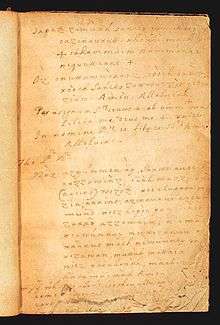Piscataway language
| Piscataway | |
|---|---|
| Native to | United States |
| Region | Maryland |
| Extinct | (date missing) |
|
Algic
| |
| Language codes | |
| ISO 639-3 |
psy |
| Glottolog |
pisc1239[1] |

Piscataway is an extinct Algonquian language formerly spoken by the Piscataway, a dominant chiefdom in southern Maryland on the Western Shore of the Chesapeake Bay at time of contact with English settlers.[3] Piscataway, also known as Conoy (from the Iroquois ethnonym for the tribe), is considered a dialect of Nanticoke.[4]
This designation is based on the scant evidence available for the Piscataway language. The Doeg tribe, then located in present-day Northern Virginia, are also thought to have spoken a form of the same language. These dialects were intermediate between the Native American groups of Lenape languages formerly spoken to the north of this area (in present-day Delaware and New Jersey) and the Powhatan language, formerly spoken to the south, in what is now Tidewater Virginia.
Classification
Piscataway is classified as an Eastern Algonquian language:
- Algic (42)
- Algonquian (40)
- Eastern Algonquian (12)
- Nanticoke-Conoy (2)
- Nanticoke [nnt] (A language of United States)
- Piscataway [psy] (A language of United State)
- Nanticoke-Conoy (2)
- Eastern Algonquian (12)
- Algonquian (40)
History
The Piscataway dialect, an individual from the Eastern Algonquian family, is extinct. According to The Languages of Native North America, Piscataway, otherwise called Conoy (from the Iroquois name for the tribe), was a dialect of Nanticoke.[4] This assignment depends on the insufficient accessible proof of both dialects. It is identified with the gathering of Delaware dialects, and all the more nearly to Powhatan, which were formerly spoken in the area of present-day Virginia. The first speakers lived on the western shore of the Chesapeake Bay, today part of Maryland. In particular, they occupied the range of the lower Potomac and Patuxent River seepages.
The Piscataway dialect was a piece of the huge Algonquian dialect family. The Jesuit evangelist Father Andrew White translated the Catholic Catechism into the Piscataway language in 1610, and other English teachers gathered Piscataway-dialect materials. The original copy is a five-page Catholic instruction written in an Eastern Algonquian dialect. It is the main surviving record of the dialect which is ventured to be Piscataway (additionally called Conoy). It is identified as such due to its attribution to Father White.[5]
Geographical distribution
This language was only spoken in Maryland.
Official status
Piscataway is an extinct language
Grammar
Morphology
Both inflectional and deduction morphological procedures are clear in the questioning. A few, for example, prefixation, obviously mirror the worldview discovered for the most part in the 108 group of dialects. The confirmation for TI and TA derivational morphemes taking after the example of Delaware proposes close ties between those dialects and Piscataway. In addition, the proof of any morphological procedures, particularly the utilization of plural articulation are found on a few things.
Phonology
This section gives the phoneme inventory as reconstructed by Mackie (2006).
| Bilabial | Alveolar | Post- alveolar |
Palatal | Velar | Glottal | ||
|---|---|---|---|---|---|---|---|
| Plosive | p | t | k | ||||
| Affricate | tʃ | ||||||
| Nasal | m | n | |||||
| Fricative | plain | s | ʃ | x | h | ||
| voiced | z | ||||||
| Approximant | w | j | |||||
| Short | Long | |
|---|---|---|
| Close | i | |
| Mid | e | eː |
| Open | a | |
| Back-mid | o | oː |
| Back-close | u | uː |
Notes
- ↑ Hammarström, Harald; Forkel, Robert; Haspelmath, Martin, eds. (2017). "Piscataway". Glottolog 3.0. Jena, Germany: Max Planck Institute for the Science of Human History.
- ↑ "Manuscript prayers in Piscataway ." Treasures of Lauinger Library. (retrieved 4 Jan 2010)
- ↑ Raymond G. Gordon Jr., ed. 2005. Ethnologue: Languages of the World. 15th edition. Dallas: Summer Institute of Linguistics.
- 1 2 Mithun, Marianne (1999). The languages of Native North America. Cambridge University Press. ISBN 0-521-23228-7.
- 1 2 Mackie, Lisa (2006). "Fragments of Piscataway: A Preliminary Description" (PDF). Retrieved February 12, 2016.
References
- Mackie, Lisa (2006). Fragments of Piscataway: A Preliminary Description. Retrieved February 12, 2016.
- OLAC resources in and about the Piscataway language
- A section of a catechism, probably in the Piscataway language, written by Andrew White, S.J.
- Nanticoke Language [archive]
- Fragments of Piscataway: A Preliminary Description
- Nanticoke Color Words
- http://www.ethnologue.com/language/psy